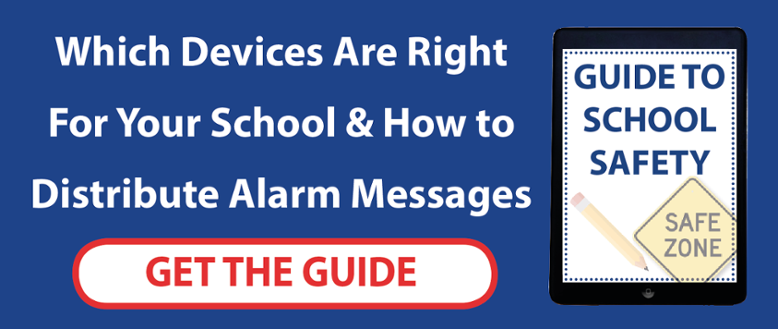
When it comes to the list of priorities that senior staff have to consider when running their schools, safety is one of the first things to be considered. For teachers to be able to foster a positive and effective learning environment, it is essential that both they and their students feel secure when within the walls of the school. However, from time to time, things do go wrong, putting pupils and staff alike at risk. Threats can range from hazards like fires or individual accidents, to acts of vandalism or even violence being perpetrated by students or even intruders from outside. Most schools already have basic measures in place to deal with such situations, but are they sufficient and how can we take things to the next level and provide a truly comprehensive level of safety?
In most schools across the country, events such as fires that threaten the wellbeing of the entire school will be reacted to by the triggering of a traditional alarm in order to signal an evacuation. As a first step to safeguard students and staff, this is extremely effective, though it does mean that some information can be lost in the confusion, potentially resulting in difficulties for emergency services and greater damage to the school. Additionally, if a staff member is unable to reach an alarm in a timely fashion, then lives could be put at risk. In the event of a smaller scale emergency, staff may have to directly call for help themselves, or rely on making a telephone call to a colleague in order to get aid. Obviously this is not sufficient, as there is no guarantee that a verbal plea or help will be answered, especially if the situation is time sensitive, such as in cases of accidents or violent attacks. However, by using alarm devices, we can markedly improve staff safety in schools.
The most basic and effective upgrade that a company such as ANT can offer to an existing alarm system, is the installation of an automated reporting system (known as a critical alarm management system) and an associated app. This app can be downloaded to smart devices used by staff (such as phones, tablets or desktops) and can then be used to raise alarms or low-priority technical calls via a centralised network that is easy to both view and update. However, in the event of a serious emergency, the staff member can quickly use their device to raise a high priority alarm that will send out notifications to other staff members, instantly making them aware of the situation.
This means that more detail can be given in the event of a situation like a fire occurring – letting teachers know which areas to avoid during the evacuation. Additionally, it can be used to instantly summon help to a specific location if a staff member is injured or having difficulty with a misbehaving student and thinks that the situation could escalate. In facilities with an especially high risk of violence, panic buttons can be installed or even issued as a wearable item. For educators dealing with children with severe learning difficulties, this can be increasingly useful; Nation Education Union figures show how recent funding constraints have had a direct impact on the availability of specialist staff, putting remaining teachers at greater risk of injury. This makes it more important than ever to be able to provide coverage of classes where children may get out of hand.
Alongside software packages, actual communications hardware is also readily available, with many emergency devices still offering full smart functionality, but with an extra layer of protection and toughness built in. This also makes it easier than ever to distinguish between personal and work devices. Furthermore, specialised alarm devices can be used in sites that have poor or even no mobile phone reception, instead utilising existing wireless data networks or radio frequencies in order to ensure that vital data is always relayed back to the alarm management system and other staff. This makes such devices ideal for schools in heavily built up areas or those in very rural environments. For locations with even worse problems with signal interference or coverage, signal boosters can be deployed around the grounds in order to make sure that radios are able to broadcast from any spot on the premises.
This plays into another key strength of dedicated alarm devices, namely their ability to protect staff even after the school day is over. Maintenance staff are especially at risk of falling victim to an accident after hours, which lessens the chance of them being able to call for help or be noticed if they are incapacitated. Fortunately, the devices provided by ANT can be set up to tackle this problem – being able to detect when someone is lying horizontal, for instance. In this instance, the device will prompt the worker to confirm that they are unhurt and if no response is forthcoming, automatically raise an alarm, bringing other workers to their location. This alarm can then be escalated to senior staff or to emergency services if so required.
ANT provide a wide range of safety products designed not just for industrial settings, but also for use in a wide range of sensitive locations. Schools are no exception, as their fast-paced and demanding working environments require safety solutions that will add the maximum level of efficiency possible, whilst at the same time requiring minimal disruptive retraining or familiarisation courses. By integrating software and hardware solutions into existing alarm systems and procedures, ANT ensures that educators can easily expect a far higher level of staff safety in their schools and enjoy the benefits of a truly modern alarm system.





